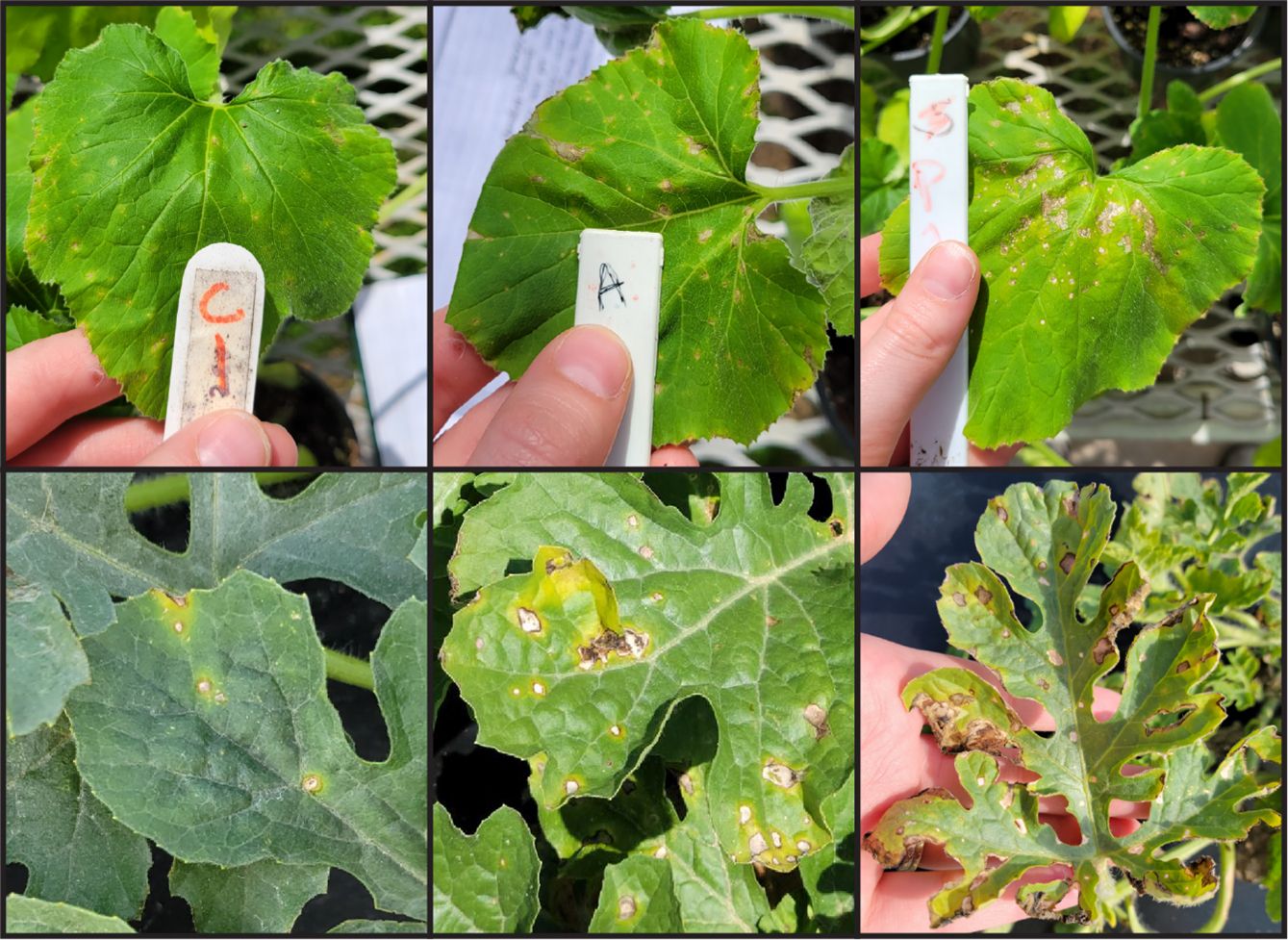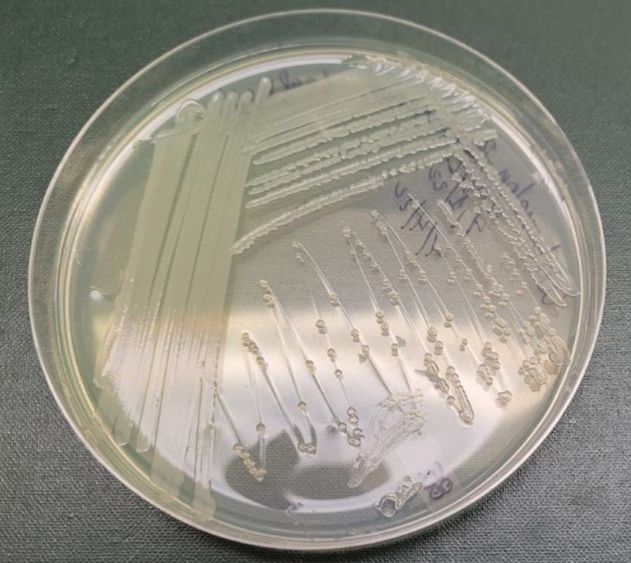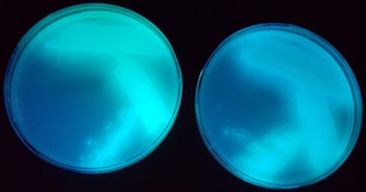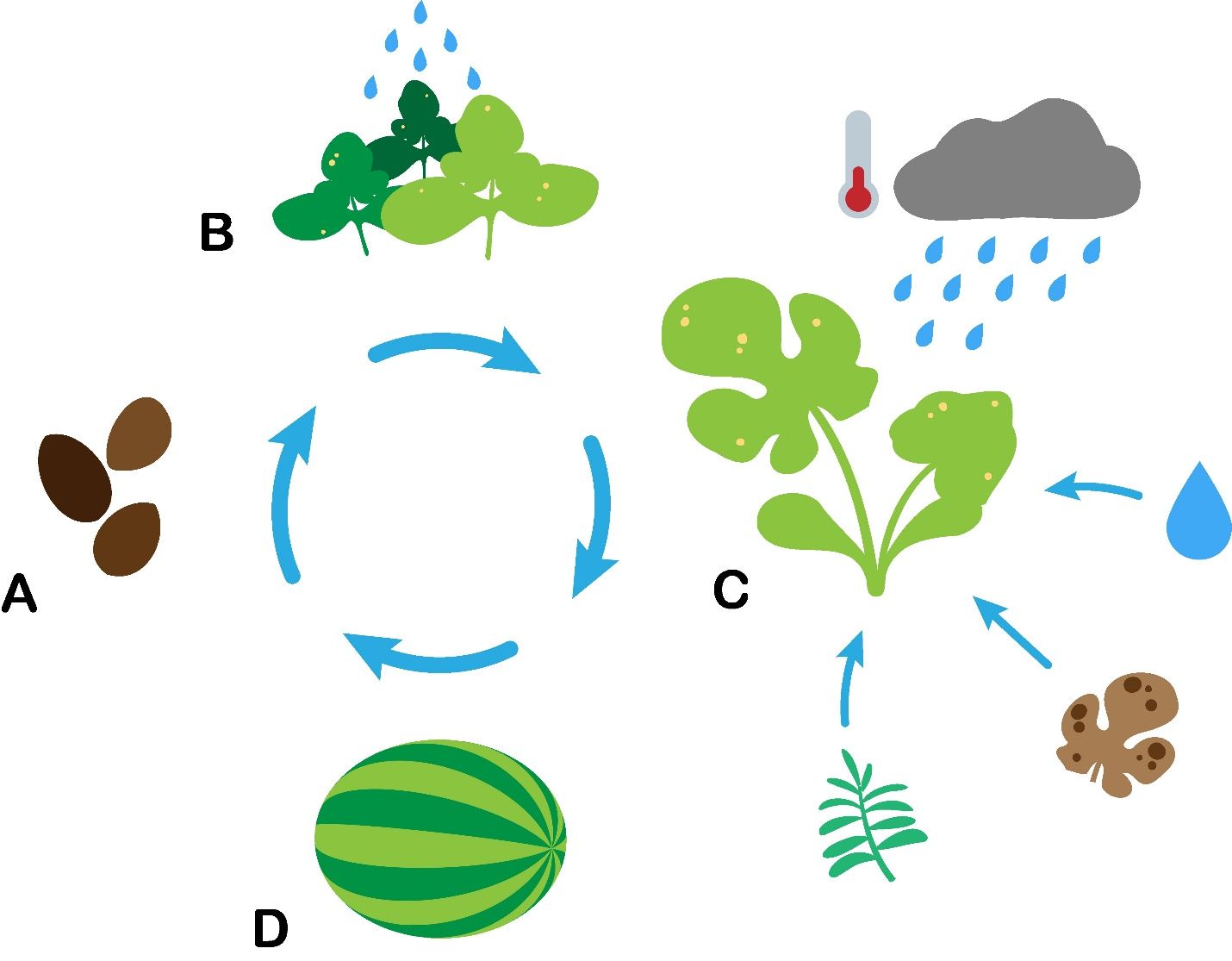Introduction
Bacterial leaf spot (BLS) of cucurbits, also known as angular leaf spot, is a foliar disease which affects cucurbitaceous crops and has been documented worldwide in nearly all cucurbit-growing regions (Bhat et al. 2010; Keinath et al. 2018). In the United States, the disease was first documented in Florida on watermelon in 1963 (Mullin and Schenck 1963) and has caused multiple outbreaks in the Southeast since then (Dutta et al. 2016; Langston Jr. et al. 2003; Newberry et al. 2015; Quesada-Ocampo 2016). The disease can infect most cucurbits including economically significant crops such as watermelon (Citrullus lanatus), melon (Cucumis melo), cucumber (Cucumis sativus), pumpkin (Cucurbita pepo), and squashes (Cucurbita maxima, Cucurbita pepo) (Bhat et al. 2010; Keinath et al. 2018).
The disease emerges sporadically under cool, wet conditions like those of early spring in the southeastern United States. Disease severity has been shown to increase with rainfall and cooler temperatures, with most severe disease symptoms occurring below 72.5˚F (22.5˚C) (Newberry 2017). Prolonged periods of favorable conditions can lead to severe outbreaks, while increasing temperatures later in the spring generally cause the disease to subside. In 2013–2014 in southern Georgia and Florida, widespread outbreaks led to transplant death, foliar blighting, delayed fruit production, and an estimated yield loss of 5%–15% (Newberry et al. 2015; Newberry et al. 2017). In Florida, as many as 7,400 acres of watermelon and squash production were impacted during this period (Newberry et al. 2015).
BLS is generally attributed to the bacterium Pseudomonas syringae and was historically believed to be caused solely by P. syringae pv. lachrymans. However, recent research implicates multiple P. syringae pathovars, including pathovars syringae and aptata (Langston Jr. et al. 2003; Newberry et al. 2018; Tian et al. 2017), as well as other Pseudomonas species, including P. alliivorans, P. capsici, P. cichorii, and P. viridiflava (Fullem et al. 2024; Newberry et al. 2016; Obradovic and Arsenijevic 2002), as causal agents of the disease.
This publication is intended to provide information on the disease bacterial leaf spot of cucurbits, its epidemiology, and management to cucurbit growers in the southeastern United States.
Symptoms
Symptoms of BLS vary according to host and climatic conditions (Keinath et al. 2018). On watermelon, the disease begins with the development of small, tan, necrotic lesions on the leaves. These lesions may darken with age, creating brown spots with or without tan centers. Lesions may be circular or irregular in shape and are commonly surrounded by a chlorotic “halo.” They may appear wet or water-soaked and can grow and coalesce to create large, blighted areas (Figure 1) (Keinath et al. 2018; Newberry et al. 2017). On pumpkin, lesions are described as dark green, transparent, greasy, water-soaked, and surrounded by chlorotic halos (Balaž et al. 2014). Symptoms on cantaloupe include small lesions (2–5 mm in size), which are angular in shape, may be tan or dark, and are also surrounded by chlorotic halos. On squash, symptoms begin as dark and water-soaked lesions. They range in size from 5 to 10 mm, are surrounded by chlorosis, and may lead to leaf distortion (Keinath et al. 2018; Langston Jr. et al. 2003). On summer squash (Cucurbita pepo) inoculated for pathogenicity assays and grown under greenhouse conditions, symptoms were observed as small tan “pinpoint” lesions, which grew and coalesced as the disease progressed (Figure 1).

Credit: K. Fullem
Causal Organisms
Although multiple Pseudomonas species have been implicated as causal agents of BLS, Pseudomonas syringae is still the most commonly detected from field samples.

Credit: K. Fullem
P. syringae can produce a yellow pigment which fluoresces under UV light. This unique property can be used as a diagnostic tool to identify a bacterium as a member of the Pseudomonas genus.

Credit: K. Fullem
Disease Cycle and Epidemiology
Cool and wet weather, specifically temperatures below 72.5˚F (22.5˚C), favors the development of BLS (Newberry 2017). Therefore, the disease is most likely to occur in the early spring in the Southeast, putting early-season cucurbit transplants at particular risk for infection.
BLS is a seedborne disease, and seeds may serve as a source of primary inoculum for outbreaks (Figure 4A) (Keinath et al. 2018; Lamichhane et al. 2015). In transplant production, closely spaced plants and overhead irrigation allow the bacteria to spread from infected to healthy plants (Figure 4B). The same occurs when transplants leave the nursery and are shipped and stored in enclosed humid trailers.
In the field (Figure 4C), bacteria may spread from infected transplants through water splashing from rain or irrigation events, contaminated tools or equipment, and insects. P. syringae may also be introduced into cucurbit production through infected non-cucurbit crops and weeds as well as rain (Lamichhane et al. 2015). Infested crop residue may harbor the bacteria for up to two and a half years and serves as an additional potential source of inoculum (Keinath et al. 2018; Lamichhane et al. 2015).
Eventually, bacteria in an infected plant may travel through the plant to the fruit where it can infect new seeds (Figure 4D) (Kritzman and Zutra 1983). If these seeds are harvested and used for seedling production, the disease cycle can begin again.

Credit: K. Fullem
Disease Management
Management of BLS is mainly focused on prevention. It is recommended to use certified disease-free seed and to rotate fields to non-cucurbit crops for at least two years between cucurbit plantings (Keinath et al. 2018). Some BLS-resistant cucumber varieties are currently available (Cramer and Downing 2022). Additionally, using drip irrigation instead of overhead irrigation can reduce bacterial spread that occurs through water splashing, and using tillage can help break down crop residues that may harbor bacteria. Biological controls may have some efficacy but have been inconsistent under field conditions. Preventative copper sprays are commonly used for BLS control, but their efficacy may be limited in cases of severe disease (Keinath et al. 2018; Newberry et al. 2017).
A study conducted by Newberry et al. (2017) tested the efficacy of weekly applications of acibenzolar-S-methyl (ASM)(Actigard®) as well as copper hydroxide with or without ethylene bis-dithiocarbamate (EBDC) (Kocide 3000®, ManKocide®) to suppress disease in watermelon transplants inoculated with P. syringae. Weekly applications of Actigard®, whether foliar or via drip tape, and foliar applications of ManKocide® were found to effectively reduce disease severity in the field. Use of ManKocide® was most effective, resulting in statistically lower levels of BLS (measured as standardized area under disease progress curve) than all other treatments in all trials. ManKocide® was found to work well either as a preventative or curative treatment in young transplants, potentially because it prevented the spread of inoculum from infected tissues to newly developing foliage in growing crops. Actigard® in either application type was also effective, but its results were less consistent than ManKocide®.
Growers are encouraged to consult their local UF/IFAS Extension office and the Florida Vegetable Production Handbook (https://edis.ifas.ufl.edu/publication/cv292) for a list of approved products and recommendations for prevention or treatment of BLS on cucurbits.
References
Balaž, J., R. Iličić, S. Maširević, D. Jošić, and S. Kojić. 2014. “First Report of Pseudomonas syringae pv. syringae Causing Bacterial Leaf Spots of Oil Pumpkin (Cucurbita pepo) in Serbia.” Plant Disease 98 (5). https://doi.org/10.1094/PDIS-07-13-0714-PDN
Bhat, N. A., K. A. Bhat, M. Y. Zargar, M. A. Teli, M. Nazir, and S. M. Zargar. 2010. “Current Status of Angular Leaf Spot (Pseudomonas syringae pv. lachrymans) of Cucumber: A Review.” International Journal of Current Research 8:901–911.
Cramer, C., and C. Downing. 2022. Disease-Resistant Cucurbit Varieties. Cornell Vegetables, Resources for Commercial Growers.
Dutta, B., R. D. Gitaitis, J. E. Driver, and S. Smith. 2016. “First Report of Bacterial Leaf Spot on Watermelon Caused by Pseudomonas syringae pv. syringae in Georgia.” Plant Disease 100 (2). https://doi.org/10.1094/PDIS-06-15-0658-PDN
Fullem, K. R., M. M. Pena, N. Potnis, E. M. Goss, G. V. Minsavage, F. B. Iriarte, A. Holland, J. B. Jones, and M. L. Paret. 2024. "Unexpected Diversity of Pseudomonads Associated with Bacterial Leaf Spot of Cucurbits in the Southeastern United States." Plant Disease 108 (3): 592–598. https://doi.org/10.1094/PDIS-06-23-1081-SR
Keinath, A. P., W. M. Wintermantel, and T. A. Zitter. 2018. Compendium of Cucurbit Diseases and Pests (2nd edition). APS Press. https://doi.org/10.1094/9780890545744
Kritzman, G., and D. Zutra. 1983. “Systemic Movement of Pseudomonas syringae pv lachrymans in the Stem, Leaves, Fruits, and Seeds of Cucumber.” Canadian Journal of Plant Pathology 5 (4): 273–278. https://doi.org/10.1080/07060668309501610
Lamichhane, J. R., A. Messéan, and C. E. Morris. 2015. “Insights into Epidemiology and Control of Diseases of Annual Plants Caused by the Pseudomonas syringae Species Complex.” Journal of General Plant Pathology 81 (5): 331–350. Springer Tokyo. https://doi.org/10.1007/s10327-015-0605-z
Langston Jr., D. B., F. H. Sanders, J. H. Brock, R. D. Gitaitis, J. T. Flanders, and G. H. Beard. 2003. “First Report of a Field Outbreak of a Bacterial Leaf Spot of Cantaloupe and Squash Caused by Pseudomonas syringae pv. syringae in Georgia.” Plant Disease 87 (5): 600. https://doi.org/10.1094/PDIS.2003.87.5.600B
Mullin, R. S., and N. C. Schenck. 1963. “Bacterial Leaf Spot on Watermelon.” Plant Disease Reporter 479:848.
Newberry, E. A. 2017. Bacterial Leaf Spot of Watermelon Caused by Pseudomonas syringae: Genotypic Diversity, Epidemiology, and Disease Management [Dissertation]. University of Florida. https://doi.org/10.1094/PDIS-11-16-1628-RE
Newberry, E. A., B. Babu, P. D. Roberts, N. S. Dufault, E. M. Goss, J. B. Jones, and M. L. Paret. 2018. “Molecular Epidemiology of Pseudomonas syringae pv. syringae Causing Bacterial Leaf Spot of Watermelon and Squash in Florida.” Plant Disease 102 (3): 511–518. https://doi.org/10.1094/PDIS-07-17-1002-RE
Newberry, E. A., M. L. Paret, J. B. Jones, and S. C. Bost. 2016. “First Report of Leaf Spot of Pumpkin Caused by Pseudomonas cichorii in Tennessee.” Plant Disease 100 (11): 2159–2160. https://doi.org/10.1094/PDIS-11-15-1387-PDN
Newberry, E. A., M. L. Paret, J. B. Jones, L. Ritchie, J. H. Freeman, N. S. Dufault, B. Babu, E. M. Goss, G. E. Vallad, P. D. Roberts, B. Hochmuth, A. Drew, and K. Beckham. 2015. “Characterization of Pseudomonas syringae Associated with Watermelon and Squash Disease Outbreaks in Florida and Georgia.” 2015 APS Southern Division Meeting Abstracts:8.
Newberry, E. A., L. Ritchie, B. Babu, T. Sanchez, K. A. Beckham, J. B. Jones, J. H. Freeman, N. S. Dufault, and M. L. Paret. 2017. “Epidemiology and Management of Bacterial Leaf Spot on Watermelon Caused by Pseudomonas syringae.” Plant Disease 101 (7): 1222–1229. https://doi.org/10.1094/PDIS-11-16-1628-RE
Obradovic, A., and M. Arsenijevic. 2002. “First Report of a Wilt and Stem Rot of Muskmelon and Watermelon Transplants Incited by Pseudomonas cichorii in Serbia.” Plant Disease 86 (4). https://doi.org/10.1094/PDIS.2002.86.4.443C
Quesada-Ocampo, L. 2016. “Pseudomonas Leaf Spot Reported on Watermelon Transplants.” North Carolina University Extension Plant Pathology. https://plantpathology.ces.ncsu.edu/2016/05/pseudomonas-leaf-spot-reported-on-watermelon-transplants/
Tian, Y., Y. Zhao, X. Chen, Y. Dai, W. Zhao, B. Hu, and R. R. Walcott. 2017. “Evidence for a Novel Phylotype of Pseudomonas syringae Causing Bacterial Leaf Blight of Cantaloupe in China.” Plant Disease 101 (10): 1746–1752. https://doi.org/10.1094/PDIS-01-17-0110-RE